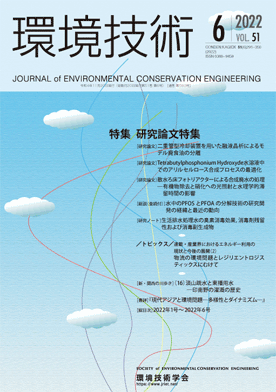
- Issue 6 Pages 293-
- Issue 5 Pages 239-
- Issue 4 Pages 179-
- Issue 3 Pages 121-
- Issue 2 Pages 93-
- Issue 1 Pages 6-
- |<
- <
- 1
- >
- >|
-
Saki OHISHI, Shogo TAGUCHI, Hiroshi SATONE, Kazuhiro ITOH, Kouji MAEDA ...Article type: research-article
2022 Volume 51 Issue 6 Pages 293-300
Published: November 20, 2022
Released on J-STAGE: December 01, 2022
JOURNAL FREE ACCESSEmploying a Couette-Taylor-type cooling apparatus equipped with coaxially positioned inner and outer cylinders, we applied melt crystallization to a binary mixture containing stearic acid and oleic acid, with the aim of forming a stearic acid-rich phase as a solid layer on the inner cylinder. As a result of the formation of a Taylor vortex flow in the annular space between the two cylinders, the solid layer exhibited a unique wavy surface. The molar ratio of stearic acid in the solid layer increased on increasing the rotational speed of the inner cylinder. A comparison of the composition of the concave and convex parts of the solid layer revealed the molar ratio of stearic acid on the concave parts to be greater than that on the convex parts, presumably because of the lower growth rate of the solid layer on the concave parts than on the convex parts.
View full abstractDownload PDF (1199K) -
Takeshi, KAKIBE, Seiji KATSURA, Miho YAMAMOTO, Satoshi MATSUDA, Hajime ...Article type: research-article
2022 Volume 51 Issue 6 Pages 301-307
Published: November 20, 2022
Released on J-STAGE: December 01, 2022
JOURNAL FREE ACCESSFrom the viewpoint of environmental protection and sustainability, developing green synthetic processing methods for cellulose derivatives, the most abundant biomass on Earth, is crucial. In this study, allyl cellulose was synthesized under homogeneous conditions. Cellulose was first dissolved in a tetrabutylphosphonium hydroxide aqueous solution, after which the resulting solution was derivatized with allyl bromide (AllylBr) to yield allyl cellulose. Allyl cellulose with a degree of substitution (DS) of 1.66 - 2.15 was synthesized at 25℃ within 1h. The DS values of the products could be well controlled simply by adjusting the AllylBr addition rate. Overall, the studyʼs findings provide insights into the development of a facile and highly efficient energy-saving synthetic method for allyl cellulose.
View full abstractDownload PDF (916K) -
Effects of Light and Hydraulic Retention Time on Organic Matter Removal and NitrificationShinnosuke KATO, Akito CHUJO, Kaito NOMURA, Satoshi SODAArticle type: research-article
2022 Volume 51 Issue 6 Pages 308-315
Published: November 20, 2022
Released on J-STAGE: December 20, 2022
JOURNAL FREE ACCESSA trickling photobioreactor (ID 13.5 ㎝, H 30 ㎝, 3 layers) packed with polyester cubes (8㎤, occupancy 47%) was fed with synthetic wastewater (TOC 104 ㎎/L, T-N 50 ㎎/L, PO43--P 11 ㎎/L)to demonstrate high wa,tewater treatment performance by algal–bacterial consortia at hydraulic retention time (HRT) of 12-2h with red LED irradiation (15 µmol/㎡/s, L:D=12h/12h). The effluent TOC, T-N, and PO43--P concentrations at HRT of 12h were4.5 ㎎/L, 29.3 ㎎/L, and 8.1 ㎎/L, respectively, for the photoreactor and 9.1 ㎎/L, 40.5 ㎎/L, and 7.2 ㎎/L for the conventional trickling filter without LED irradiation. The photoreactor with green algae, diatoms, and bacteria had high capabilities for TOC removal, nitrification, and carbon-utilization potential at HRT longer than 8h.
View full abstractDownload PDF (1091K)
-
Yoko FUJIKAWA, Ayumi HASHIGUCHIArticle type: Review
2022 Volume 51 Issue 6 Pages 316-326
Published: November 20, 2022
Released on J-STAGE: December 20, 2022
JOURNAL FREE ACCESSThe target of the review article is to discuss the state-of-the art technologies applicable to the remediation of PFOA and PFOS contamination of the water environment. Firstly, we summarize the pollution of the environment with PFOA and PFOS to clarify the treatment technologies required in the field. Then we outline the principle and effectiveness of the existing treatment technology for PFOA and PFOS, with more focus on decomposition rather than sequestering techniques. The difficulties encountered in the decomposition of these substances are explained from their chemical structure and properties. Finally, combinations of feasible treatment technologies, i. e., treatment train, to PFOA and PFOS in water are discussed.
View full abstractDownload PDF (948K)
-
Koji TOSA2022 Volume 51 Issue 6 Pages 327-331
Published: November 20, 2022
Released on J-STAGE: December 20, 2022
JOURNAL FREE ACCESSTo investigate the applicability of bromine disinfection to domestic wastewater, septic tank water was disinfected via bromination, and the disinfection efficacy, disinfectant persistence, and trihalomethane formation were compared with those under disinfection via chlorination. The effect of bromine disinfection on coliforms was higher than that of chlorine disinfection. The residual disinfectants were similar at the same injection rate under both chlorination and bromination. Although small amounts of trihalomethanes were generated, the concentrations were extremely low compared to the quality standards for drinking water in Japan. The results suggest that bromination is useful for disinfection of domestic wastewater.
View full abstractDownload PDF (843K)
- |<
- <
- 1
- >
- >|